Zombie Highways

Blueprint America — with The NewsHour with Jim Lehrer — in a story on how America’s highways are built and funded — often times at the expense of mass-transit development. Correspondent Rick Karr reports from Birmingham, Alabama.
What’s a Zombie Highway?
Rick Karr, Blueprint America correspondent
Let me answer that question with a hypothetical: Let’s pretend that the federal government has a program to help you improve your house or apartment. Lawmakers in Washington promise that for every dollar that you put up for construction, they’ll give you four dollars. It doesn’t matter how expensive the project turns out to be –- you’ll get four bucks in subsidies for every dollar that comes out of your own pocket. Until the project is finished.
In that case, would you ever have an incentive to finish your home improvement project? Or would the project keep shambling forward, like an extra in a George Romero film?


